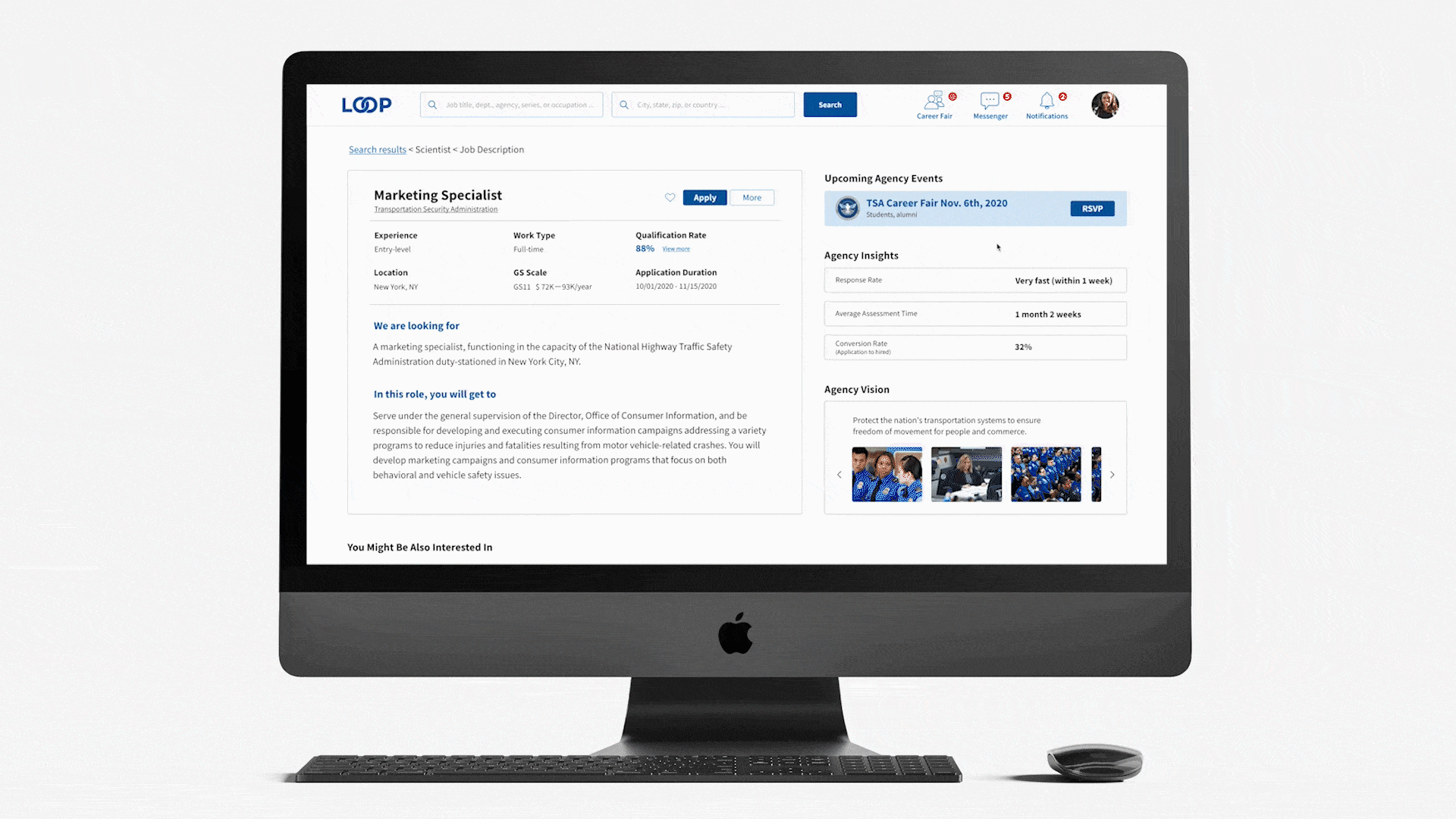LOOP
LOOP is a reciprocal recruiting and onboarding platform for candidates searching for federal jobs and talent acquisition professionals.
SCADpro Sponsored Project
Role: UX Associate Lead & Art Director
Tools: Figma, Adobe Photoshop, Illustrator, InDesign
Duration: 10 Weeks (09.2020 - 11.2020)
Design Prompt
With the job market becoming increasingly competitive, designing an accessible and transparent candidate experience is essential for attracting quality talent.
Research Question
Design Process
Stakeholder Map
A stakeholder map was crafted to prioritize and identify target users. This was followed by in-depth interviews with twelve campus hires, ten experienced hires, and seven talent acquisition (TA) leads across the federal and private sectors.
Research Framework
After the synthesis of the research, the team developed a research framework based on the correlations between data points. The framework displays the requirements of the user, inspiring future design opportunities.
An ideal job portal must be user-centric and responsive to ensure a high conversion rate of quality candidates through meaningful conversations. An ideal job portal must also incorporate automation techniques to boost the overall efficiency of the candidate experience.
Candidate
TA Expert
Federal Government Agency
Personas
The data points and interviews revealed the behaviors and characteristics of the users, shaping our design metric.
Candidate Personas
The candidate persona was developed based on the experience of the user. There are two kinds of candidates: those who lack work experience and those who have more extensive work experience.
HR Personas
The HR personas were developed based on their activities during the recruitment process. There are three kinds of TA professionals: HR Managers, TA Advisors, and Recruiters.
Journey Maps
To get a better understanding of the behavior and psychology of our users, the team recorded observations of their actions, thoughts, and emotions.









Design Metric
To guide future design decisions, the team developed a design metric: the design should promote efficiency, improve quality, enhance transparency, and boost attraction.
Key Scenario
A detailed key scenario was formulated to explain the flow of activities on the portal.
Final Solution
It is not enough to address only one
aspect of the problem. The HR and their experiences and the
candidate experiences are intertwined with each other, by
their nature. Their relationship resembles a loop of
experiences that is always in sync.
LOOP is the digital service that bridges the gap between the
front-end candidates and the back-end HR. It represents the
facilitation of the interconnected job application system.
Candidate Portal
The candidate portal is designed for candidates to elevate their job-seeking experience by providing accurate job recommendations. Additionally, it extends interaction through virtual career fairs and enhances awareness through the candidate dashboard.
Candidates receive updates through an application tracker and are able to schedule interviews through calendar invites on the platform.

Welcome Page

Job Search

Scheduling Interview

Career Fair
Candidate Portal: Information Architecture
Detailed information architecture was developed to demonstrate the structure of the candidate portal.
Candidate Portal: Flow Chart
The flowcharts below demonstrate the user flow in each key scenario.




HR Platform
The HR platform consists of three portals: Recruiters, Talent Acquisition Advisors, and Human Resource Managers, based on the nature of their role in an organization. The goal is to boost efficiency in workflow and to design an engagement strategy to attract high-quality candidates.
This can be achieved by minimizing the screening workload through automation, enhancing transparency, and reducing communication barriers when scheduling an interview.
HR Platform: Information Architecture
The detailed information architecture of the HR platform was created to explain the flow of activities step by step.
Service Blueprint
A service blueprint explained the detailed interactions between the candidate portal and the HR platform.
Ecosystem of LOOP
To narrow down the product scope, a diagram to outline the ecosystem and touchpoints within the service’s scope was created. The system engages two user groups through different digital touchpoints.
One is the HR platform that supports the TA recruiting process along with Monster. The other is a candidate job portal that supports the job-seeking process, apart from the application process currently happening on USAJobs. Both systems are capable of the import and export of information from USAJobs and Monster.
Product Vision
To demonstrate the vision of LOOP, a product vision board was developed based on the initial research. The vision board is a tool that captures the interpretation of user needs, key product features, and the overall value LOOP must create to serve federal agencies.
Marketing Channels
Appendix: Process Book Design



























